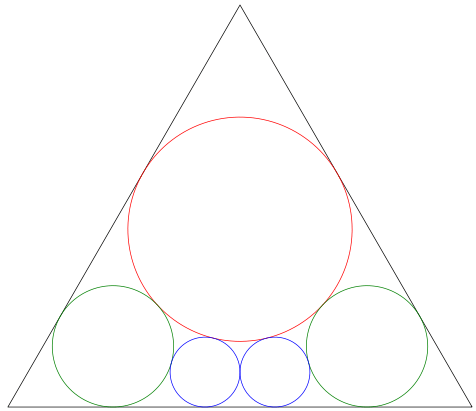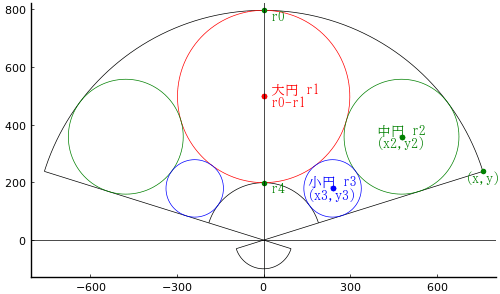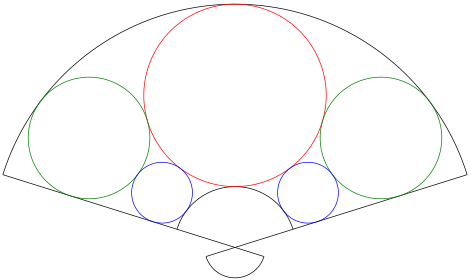算額(その225)
バージョンアップ https://blog.goo.ne.jp/r-de-r/e/b049f677e607ba6a92b04bb805ae3b0f
中村信弥「改訂増補 長野県の算額」
http://www.wasan.jp/zoho/zoho.html
県内の算額3(205)
長野県千曲市八幡 八幡八幡神社 文久2年(1862)
基本的に,算額(その22)と同じである。
岩手県遠野市附馬牛町 早池峰神社
http://www.wasan.jp/iwate/hayatine.html
三角形の中に天円,地円,無名円 5 個が入っている。天円の径が 1 寸のとき,地円の径はいかほどか。

図のように記号を定める。
天円の半径,中心座標を r1, (0, y1)
地円の半径,中心座標を r2, (x2, y2)
無名円の半径,中心座標を r3, (r3, r3)
とする。
以下の連立方程式を立て,nlsolve() で数値解を求める。
using SymPy
function distance(x1, y1, x2, y2, x0, y0)
p1, p2 = sympy.Point(x1, y1), sympy.Point(x2, y2)
l = sympy.Line(p1, p2)
l.distance(sympy.Point(x0, y0))^2 # 二乗距離を返す!!
end;
@syms r1::positive, y1::positive, r2::positive, x2::positive, r3::positive, x0::positive, y0::positive;
r1 = 1
y0 = sqrt(Sym(3)) * x0
eq1 = r3^2 + (y1 - r3)^2 - (r1 + r3)^2
eq2 = (x2 - r3)^2 + (r2 - r3)^2 - (r2 + r3)^2
eq3 = x2^2 + (y1 - r2)^2 - (r1 + r2)^2
eq4 = distance(x0, 0, 0, y0, 0, y1) - r1^2
eq4 = (y0 - y1)/2 - r1 # 角度がわかっているので簡単になる
eq4 = 3x0^2 - (y1 + 2)^2 # 更に平方根をなくす
eq5 = distance(x0, 0, 0, y0, x2, r2) - r2^2
eq5 = (x0 - x2)/sqrt(Sym(3)) - r2
eq5 = (x0 -x2)^2 - 3r2^2; # 平方根をなくす
円の中心から三角形の斜辺までの距離が円の半径に等しいとする eq4, eq5 は,この三角形が正三角形であることから,簡約化できる。また,solve() でどの変数について解くかというリストを付けなければ,
res = solve([eq1, eq2, eq3, eq4, eq5])
で数式解を求めることはできる。
res = solve([eq1, eq2, eq3, eq4, eq5])
1-element Vector{Dict{Any, Any}}:
Dict(x0 => (-7259*sqrt(12519 + 7228*sqrt(3)) - 4187*sqrt(37557 + 21684*sqrt(3)) + 662827*sqrt(3) + 1148053)/(-47*sqrt(39)*sqrt(963 + 556*sqrt(3)) - 74*sqrt(13)*sqrt(963 + 556*sqrt(3)) + 12279 + 7092*sqrt(3)), r3 => -5*sqrt(37557 + 21684*sqrt(3))/26 - 3*sqrt(12519 + 7228*sqrt(3))/13 + 89/2 + 26*sqrt(3), r2 => (-18582228589*sqrt(37557 + 21684*sqrt(3))/13 - 32185364034*sqrt(12519 + 7228*sqrt(3))/13 + 391757368513 + 226181222168*sqrt(3))/(-20717394*sqrt(13)*sqrt(963 + 556*sqrt(3)) - 11961193*sqrt(39)*sqrt(963 + 556*sqrt(3)) + 1892677408*sqrt(3) + 3278213433), y1 => -sqrt(12519/4 + 1807*sqrt(3)) + 40 + 47*sqrt(3)/2, x2 => (-28787502 - 16620472*sqrt(3) + 2365076*sqrt(12519 + 7228*sqrt(3))/13 + 1365478*sqrt(37557 + 21684*sqrt(3))/13)/(-925*sqrt(39)*sqrt(963 + 556*sqrt(3)) - 1602*sqrt(13)*sqrt(963 + 556*sqrt(3)) + 146360*sqrt(3) + 253503))
例えば,r2 であれば,数式は
r2 => (-18582228589*sqrt(37557 + 21684*sqrt(3))/13 - 32185364034*sqrt(12519 + 7228*sqrt(3))/13 + 391757368513 + 226181222168*sqrt(3))/(-20717394*sqrt(13)*sqrt(963 + 556*sqrt(3)) - 11961193*sqrt(39)*sqrt(963 + 556*sqrt(3)) + 1892677408*sqrt(3) + 3278213433)
で,これはまさしく 0.541123647609847 を与える(以下の数値解とは若干異なる)。しかし,いずれにせよ r1 を未知としてそれぞれの解に r1 を含む形で解を得ようとすると,有限の時間内には解は求まらないようである。
そこで,いつもの対応で,nlsolve() で解を求めることにする。
println(eq1, ",")
println(eq2, ",")
println(eq3, ",")
println(eq4, ",")
println(eq5, ",")
r3^2 + (-r3 + y1)^2 - (r3 + 1)^2,
(r2 - r3)^2 - (r2 + r3)^2 + (-r3 + x2)^2,
x2^2 + (-r2 + y1)^2 - (r2 + 1)^2,
3*x0^2 - (y1 + 2)^2,
-3*r2^2 + (x0 - x2)^2,
using NLsolve
function nls(func, params...; ini = [0.0])
if typeof(ini) <: Number
r = nlsolve((vout, vin) -> vout[1] = func(vin[1], params..., [ini]), ftol=1e-14)
v = r.zero[1]
else
r = nlsolve((vout, vin)->vout .= func(vin, params...), ini, ftol=1e-14)
v = r.zero
end
return v, r.f_converged
end;
function H(u)
(y1, r2, x2, r3, x0) = u
return [
r3^2 + (-r3 + y1)^2 - (r3 + 1)^2,
(r2 - r3)^2 - (r2 + r3)^2 + (-r3 + x2)^2,
x2^2 + (-r2 + y1)^2 - (r2 + 1)^2,
3*x0^2 - (y1 + 2)^2,
-3*r2^2 + (x0 - x2)^2,
]
end;
iniv = [big"1.2", 0.5, 0.7, 0.2, 0.8]
res = nls(H, ini=iniv)
(BigFloat[1.585776115068257755122089256490132844790684509754511012457580246715684326737859, 0.5411142703251270921419775369262249321419086495250945339808838737796209260247126, 1.133011396384708951545840117932571235121725730234141906521758307553018076355822, 0.3116714054876906382129734754350708014875244562726158413609579698585776388195518, 2.070248805288389105459538534628650709909693363683297092946397231160973369434497], true)
using Printf
(a1, a2, a3, a4, a5) = res[1]
@printf("y1 = %.7f, r2 = %.7f; x2 = %.7f; r3 = %.7f; x0 = %.7f\n",
a1, a2, a3, a4, a5)
y1 = 1.5857761, r2 = 0.5411143; x2 = 1.1330114; r3 = 0.3116714; x0 = 2.0702488
地円の径は 0.5411 寸,すなわち 5分4厘1毛1糸...である。

using Plots
using Printf
function circle(ox, oy, r, color=:red; beginangle=0, endangle=360, fill=false)
θ = beginangle:0.1:endangle
x = r.*cosd.(θ)
y = r.*sind.(θ)
if fill
plot!(ox .+ x, oy .+ y, linecolor=color, linewidth=0.5, seriestype=:shape, fillcolor=color)
else
plot!(ox .+ x, oy .+ y, color=color, linewidth=0.5)
end
end;
function circle4(x, y, r, color=:red)
circle(x, y, r, color)
circle(x, -y, r, color)
circle(-x, y, r, color)
circle(-x, -y, r, color)
end;
function point(x, y, string="", color=:green, position=:left, vertical=:top; mark=true)
mark && scatter!([x], [y], color=color, markerstrokewidth=0)
annotate!(x, y, text(string, 10, position, color, vertical))
end;
function segment(x1, y1, x2, y2, color=:black; linestyle=:solid, linewidth=0.5)
plot!([x1, x2], [y1, y2], color=color, linestyle=linestyle, linewidth=linewidth)
end;
function draw(more)
pyplot(size=(500, 500), grid=false, aspectratio=1, label="", fontfamily="IPAMincho")
(y1, r2, x2, r3, x0) = res[1]
r1 = 1
y0 = sqrt(3) * x0
@printf("y1 = %.7f; r2 = %.7f; x2 = %.7f; r3 = %.7f; x0 = %.7f; y0 = %.7f\n", y1, r2, x2, r3, x0, y0)
@printf("地円の径 = %.5f\n", r2)
println("x0 = $x0")
println(float(distance(x0, 0, 0, y0, 0, y1)))
println("y0 = $y0\ny1 = $y1")
println("y0 - y1 = $(y0 - y1)")
plot([x0, 0, -x0, x0], [0, y0, 0, 0], color=:black, lw=0.5)
circle(0, y1, r1)
circle(x2, r2, r2, :green)
circle(-x2, r2, r2, :green)
circle(r3, r3, r3, :blue)
circle(-r3, r3, r3, :blue)
if more == true
point(0, y1, " y1 天円", :red)
point(x2, r2, "(x2,r2) 地円", :green, :center, :top)
point(r3, r3, "(r3,r3)", :blue, :center, :top)
point(x0, 0, " x0", :black ,:left, :bottom)
point(0, y0, " y0", :black)
hline!([0], color=:black, lw=0.5)
vline!([0], color=:black, lw=0.5)
else
plot!(showaxis=false)
end
end;




















